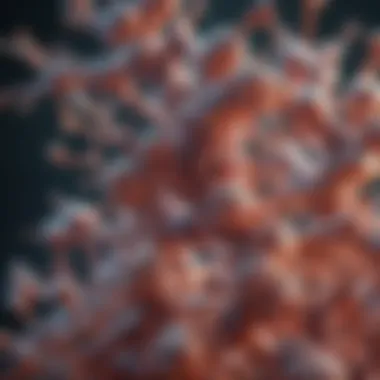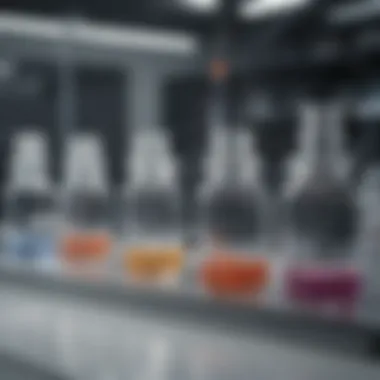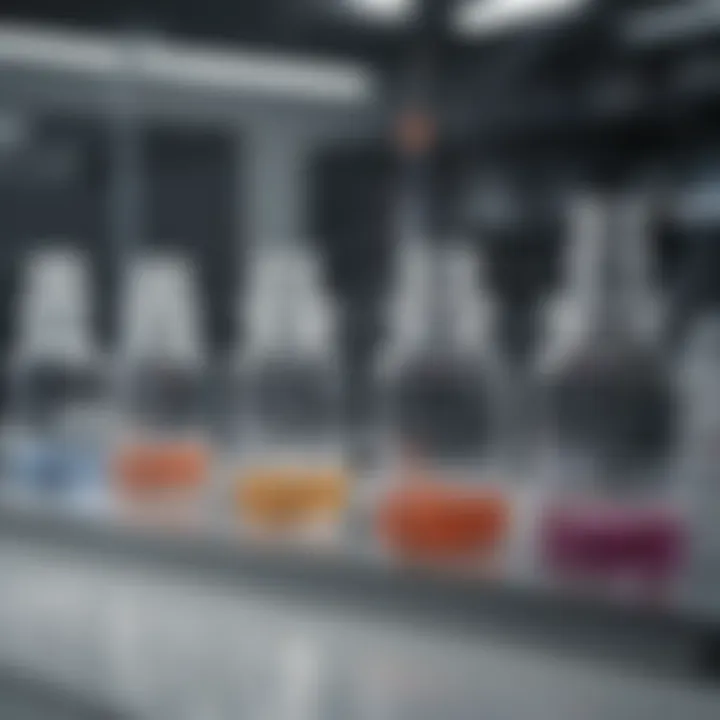GMP Antibody Production: A Detailed Guide


Intro
GMP (Good Manufacturing Practice) antibody production stands as a cornerstone in the realm of biopharmaceuticals, embodying both complexity and precision. As the demand for therapeutic antibodies surges, understanding the production process becomes more critical than ever. This overview delves into the mechanisms that drive GMP antibody production, uncovering the nuances that shape the industry. It serves to educate and guide students, researchers, educators, and professionals who navigate this intricate field, providing insights into every stage of the journey from the initial cell line development to compliance with rigorous regulatory standards.
Research Context
Background and Rationale
The production of therapeutic antibodies is not merely a technical procedure but a highly regulated endeavor that requires a deep understanding of biological systems. Given the increasing prevalence of diseases that demand advanced treatments, especially in areas like oncology and autoimmune disorders, the significance of GMP-compliant processes cannot be overstated. The rationale behind adopting Good Manufacturing Practices is rooted in ensuring that biological products are consistently produced and controlled according to quality standards. This is crucial, as any lapse may jeopardize patient safety and therapeutic efficacy.
Literature Review
In recent years, numerous studies have highlighted the evolution and importance of GMP in antibody production. The literature generally emphasizes three core areas:
- Cell Line Development: The foundation of antibody production begins here, where scientists select or engineer cell lines capable of producing the desired antibodies efficiently.
- Purification Techniques: This focuses on isolating antibodies from complex biological mixtures, ensuring that the final product is free from contaminants and maintains its intended effectiveness.
- Regulatory Compliance: The interplay between production processes and regulatory oversight is elaborated upon in various journals, shedding light on how compliance safeguards the interests of end-users and manufacturers alike.
Researchers have pointed towards methodologies that improve output while adhering strictly to GMP guidelines, illustrating a continuous effort to refine practices for optimal results.
Methodology
Research Design
The exploration of GMP antibody production requires a multifaceted research design interweaving both qualitative and quantitative approaches. A blend of case studies, laboratory experiments, and survey-based assessments can yield a comprehensive understanding. This multidisciplinary approach allows for the consideration of biological, technical, and regulatory aspects, fostering a richer narrative of the current state and future of GMP practices.
Data Collection Methods
Data collection in this domain often involves:
- Interviews with Industry Experts: These conversations can unearth valuable insights into the challenges and advancements encountered in GMP antibody production.
- Field Observations: Spending time in production facilities provides a first-hand view of processes, workflow, and adherence to GMP standards.
- Analytical Reviews: Evaluating previous studies and data helps in grounding new findings in the established literature, which adds credibility and context to current practices.
The fusion of these methods adds depth to the understanding of GMP antibody production, painting a thorough picture of what it entails, and how it continues to evolve in response to scientific and regulatory demands.
Understanding GMP in Biopharmaceuticals
Good Manufacturing Practice (GMP) is more than a set of guidelines; it represents a foundational pillar of the biopharmaceutical industry. The very essence of GMP is rooted in ensuring that products are consistently produced and controlled to quality standards appropriate to their intended use. In the realm of antibody production, GMP plays a pivotal role in safeguarding patient safety and ensuring therapeutic efficacy.
The significance of GMP in this context goes beyond mere compliance; it affects nearly every aspect of antibody manufacturing. First and foremost, GMP provides a structured framework that guides manufacturers in the development of processes that can be reliably replicated. By adhering to GMP principles, companies not only meet regulatory requirements but also build a reputation for quality and reliability in their products.
Benefits of Understanding GMP
That said, understanding GMP transcends compliance. Here are several compelling reasons why everyone involved in biopharmaceutical manufacturing should be well-versed in GMP:
- Safety Assurance: Bacteria, toxins, or other contaminants can endanger patient safety, making thorough contamination control an absolute priority.
- Quality Consistency: GMP lays down requirements for raw materials, equipment, and environment controls, resulting in consistent and high-quality end products.
- Market Reputation: Adhering to GMP fosters trust with regulatory bodies, healthcare professionals, and consumers, all of whom are increasingly discerning about product quality.
- Regulatory Alignment: A strong grasp of GMP facilitates better interaction with regulatory agencies, ensuring smoother and more predictable approval processes.
Considerations about GMP in Antibody Production
Several key factors warrant consideration when discussing GMP in the context of antibody production. First, the complexity inherent in biological systems means that each production run carries unique challenges. Thus, there is a necessity for robust documentation processes, which helps in tracking all variables and mitigating risks.
Moreover, as biopharmaceutical companies innovate, they must remain vigilant. New technologies, techniques, and therapies demand real-time adaption of GMP practices to accommodate advances while maintaining compliance. As a result, companies must invest time and resources into ongoing training and education concerning GMP standards.
"A company’s commitment to GMP is reflected not just in their products but in their culture—quality must be at the forefront of every action taken in the manufacturing process."
Antibodies: Types and Functions
Antibodies play a pivotal role in the immune system, acting as specialized proteins that identify and neutralize foreign objects like bacteria and viruses. Understanding the types of antibodies and their specific functions not only sheds light on the immune system but also emphasizes the critical role these molecules play in biopharmaceutical manufacturing, especially when it comes to therapeutic applications. The relevance of this section lies in its ability to bridge basic immunology with practical application, particularly in relation to GMP production standards, which dictate how these antibodies should be manufactured, tested, and utilized in treatments.
Monoclonal Antibodies
Monoclonal antibodies (mAbs) are a major player in modern therapy, known for their specificity. They are derived from a single clone of B cells, which means every antibody produced is identical and binds to a specific target. In the context of antibody production, this characteristic is vital because it minimizes variability and enhances consistency. The use of monoclonal antibodies spans from cancer treatments to autoimmune diseases, demonstrating their versatility. The precision of mAbs means they're tailored towards specific antigens—substances that trigger the immune response—which makes them powerful tools in both diagnostics and therapeutics.
The creation process of monoclonal antibodies typically involves fusing a specific type of immune cell, B lymphocytes, with a tumor cell to form hybridomas. These hybrid cells can multiply indefinitely while producing the antibody. The rigorous adherence to GMP standards during this process ensures that every batch is produced with the utmost care, maintaining quality and efficacy.
Polyclonal Antibodies
In contrast to monoclonal antibodies, polyclonal antibodies are a mixture of antibodies produced by different B cell lineages. They recognize multiple epitopes on an antigen. This diversity can be both an advantage and a challenge. Because they can bind to different parts of the target, polyclonal antibodies might provide a more robust response, which is beneficial in various therapeutic scenarios such as infections or certain autoimmune conditions.
However, the manufacturing process can be less controlled compared to monoclonal antibodies. When produced under GMP, it's crucial to document and ensure the purity of polyclonal antibodies. Since they derive from multiple sources, quality assurance becomes paramount to avoid variations that could lead to unpredictable outcomes in therapeutic applications. The efficacy can be dependent on the source of immunization and production conditions.
Neutralizing Antibodies


Neutralizing antibodies represent a specialized class that inhibits the infectivity of pathogens. They can block the infectivity of viruses by binding to them, which is particularly critical in the development of vaccines and antiviral therapies. For instance, in the fight against viral infections like HIV or influenza, neutralizing antibodies serve not only as a defensive mechanism but also as a guiding principle for vaccine development. A strong neutralizing response is often correlated with better protection against disease.
In the realm of GMP biomanufacturing, a comprehensive understanding of neutralizing antibodies is essential. During production, assessing the neutralizing potential of antibodies through specific assays is vital to ensure that they hold the desired therapeutic effects. The characterization of these antibodies can also uncover variations in effectiveness, which may arise due to the influences of cell lines, expression systems, and purification methods used in production.
"In the realm of antibody production, knowing whether we’re dealing with monoclonal, polyclonal, or neutralizing antibodies has significant implications for both efficacy and safety in therapeutic applications."
Overall, grasping the distinctions between monoclonal, polyclonal, and neutralizing antibodies enhances our understanding of how these proteins function within the immune system. This knowledge is invaluable for researchers and professionals in the biopharmaceutical industry, fundamentally affecting production methodologies and quality assurance protocols in the context of GMP.
The GMP Antibody Production Process
The journey of producing antibodies under Good Manufacturing Practice (GMP) is a meticulous venture. Each step in the process contributes significantly to the ultimate goal: delivering safe and effective therapies. This section delves into the core components of the GMP antibody production process, illustrating how specific elements intertwine to ensure quality and safety in biopharmaceuticals.
Cell Line Development
Cell line development serves as the foundation of any antibody production effort. Creating a robust cell line is crucial because it directly affects yield and quality of the antibodies produced.
Selection of Host Cells
Choosing the right host cells impacts the efficiency and productivity of the process. Mammalian cells, particularly Chinese hamster ovary (CHO) cells, are prominent due to their ability to carry out complex post-translational modifications. These modifications are essential for the proper functioning of the antibodies produced.
- Key characteristic: The key characteristic of CHO cells is their adaptability to large-scale production. Their ability to thrive in suspension cultures thus makes them a popular choice in the industry.
- Advantages and disadvantages: On the upside, the post-translational modifications that CHO cells facilitate enhance the therapeutic efficacy of antibodies. However, one should consider the comparatively longer timeline required for their development and optimization.
Transfection Techniques
Transfection techniques are pivotal in introducing the desired genetic material into the selected host cells. These techniques not only determine the efficiency but also the stability of the produced antibodies.
- Key characteristic: Viral transduction and electroporation are prominent methods. Viral transduction offers a high efficiency of gene transfer while ensuring stable integration into the host genome.
- Advantages and disadvantages: The unique feature of using viral vectors is their ability to transduce dividing and non-dividing cells, which can be advantageous. On the other hand, integration issues may arise, leading to variable expression levels, which might necessitate multiple rounds of optimization.
Culture Expansion
Once a reliable cell line is established, the next step is culture expansion. This process is vital for increasing the biomass to the required levels for antibody production.
Scale-Up Strategies
Scale-up strategies focus on transitioning from small culture volumes to larger ones while maintaining the quality of the antibodies.
- Key characteristic: One effective strategy is using a two-stage culture system: an initial batch culture followed by a fed-batch culture. This method allows for increased productivity by replenishing nutrients over time.
- Advantages and disadvantages: The advantage of this approach lies in its ability to boost yield without overcrowding the cells. Conversely, it demands careful monitoring to maintain optimal growth conditions and can lead to inconsistencies if not managed properly.
Bioreactor Technologies
Bioreactor technology is instrumental in ensuring controlled and efficient growth of the cell lines. These systems allow for precise control over the environmental conditions.
- Key characteristic: Automated bioreactors equipped with real-time monitoring tools provide consistent and reproducible results, a significant factor for compliance with GMP regulations.
- Advantages and disadvantages: A considerable benefit is the ability to scale operations quickly. However, investment in sophisticated equipment can be quite costly, especially for smaller facilities.
Harvesting Antibodies
Harvesting is a critical phase where antibodies are collected from the culture. The effectiveness of harvesting methods can greatly influence the yield and quality of the final product.
Centrifugation Methods
Centrifugation is a widely used technique for separating the cells from the supernatant containing the antibodies.
- Key characteristic: Continuous flow centrifugation is often preferred for its efficiency in large-scale applications, allowing for a quick and effective separation process.
- Advantages and disadvantages: This method's primary advantage is its ability to maintain cell viability and prevent damage to delicate antibodies. Conversely, it can be energy-intensive, leading to increased operational costs.
Filtration Techniques
Filtration techniques follow centrifugation, aiming to clarify the supernatant and remove any particulate matter.
- Key characteristic: Tangential flow filtration is often employed in this stage, allowing for continuous processing of large volumes.
- Advantages and disadvantages: The benefit of tangential flow is its ability to concentrate antibodies while effectively removing contaminants. However, fouling of the membrane can occur, necessitating regular maintenance to ensure efficiency.
Purification and Characterization
Purification and characterization are the final steps in preparing antibodies for therapeutic use. They ensure the product is suitable for regulatory submission and clinical applications.
Chromatographic Techniques
Chromatography remains the gold standard in purification techniques for antibodies. It offers high resolution and specificity.
- Key characteristic: Affinity chromatography is notably favored due to its selective nature, allowing for the isolation of antibodies based on their affinity to a particular ligand.
- Advantages and disadvantages: This method can yield high purity levels, enhancing overall product quality. On the downside, it may require multiple rounds depending on the initial purity of the harvested antibodies, extending the processing time.
Analytical Methods


Analytical methods are crucial for characterizing the purified antibodies, ensuring they meet the necessary specifications before entering clinical trials.
- Key characteristic: Techniques such as mass spectrometry and ELISA offer detailed insights into the molecular weight and concentration of the antibodies.
- Advantages and disadvantages: These methods provide reliable results that are critical for regulatory approval. However, they can be costly and time-consuming, requiring skilled personnel for operation.
Understanding each of these elements is essential for ensuring that GMP production of antibodies is not just a theoretical exercise, but a practical reality that delivers effective therapeutic agents to those in need.
Quality Assurance in GMP Production
In the realm of biopharmaceuticals, the significance of quality assurance (QA) cannot be overstated. As antibody production processes are closely regulated, ensuring these processes meet predefined standards is vital. Quality assurance not only safeguards the integrity of the product but also reassures stakeholders about its safety and efficacy. In a market where the stakes are high, any misstep can have serious consequences — from regulatory repercussions to potential harm to patients. Thus, implementing robust quality assurance measures becomes not just a recommendation, but a prerequisite.
Compliance and Documentation
Batch Records
Batch records play a pivotal role in maintaining compliance within GMP settings. These records meticulously document each step of the production process, from the initial materials used to the final product ready for distribution. A standout feature of batch records is their ability to provide traceability, which means that if anything goes awry, one can backtrack through the entire production history. This aspect is its golden ticket in ensuring adherence to regulatory standards. Moreover, the transparency offered by batch records fosters accountability among the production team, an essential trait in high-stakes environments like this.
On the downside, the compilation of batch records can be labor-intensive. It demands precision and timeliness, which can sometimes lead to bottlenecks in the production process. Nevertheless, the advantages of having clear, comprehensive documentation far outweigh these challenges. They are indispensable in audits, and their existence can mean the difference between a pass and a fail during inspections.
Standard Operating Procedures
Standard Operating Procedures (SOPs) are the backbone of quality assurance in GMP antibody production. These documented processes define how tasks should be carried out to ensure consistency and quality across operations. One key characteristic of SOPs is their role in mitigating risks; by having a prescribed method for each task, the likelihood of errors decreases significantly. This feature grants them a central position in any discussion about quality assurance.
While SOPs help avoid mishaps, they can sometimes stifle flexibility. In fast-moving environments, sticking to a strict procedure may hinder innovation. However, the discipline that SOPs enforce is invaluable, especially when dealing with multiple teams or shifts. Their existence ensures that all team members are aligned, which plays a crucial part in producing high-quality antibodies.
Testing and Validation
Quality Control Tests
Quality control tests ensure that the antibodies produced meet the necessary quality standards. These tests can cover a range of criteria, from potency and purity to safety assessments. A defining aspect of quality control tests is their rigorous nature; they are designed to catch any deviations or out-of-specifications results before the product reaches patients. This ensures the credibility of the manufacturer, fostering trust among healthcare practitioners and patients alike.
However, implementing these tests does come with challenges. Balancing thoroughness with efficiency can create a tug-of-war, as comprehensive testing often requires time and resources. Yet, the peace of mind that quality control tests provide is unmatched. They form a safety net that protects both the manufacturer and the end-users.
Stability Studies
Stability studies are essential to understanding how antibodies preserve their efficacy and safety over time. They assess how changes in storage conditions—like temperature or light—impact the product. A unique selling point of stability studies is their predictive capability; they inform manufacturers about the shelf life and how the antibodies should be handled. This is particularly important for ensuring that therapies remain effective from the lab to the patient's hand.
Nonetheless, stability studies can sometimes be lengthy and resource-draining. The trials take time, and results may not be instantaneous. This can be challenging for companies needing quick turnaround times on their products. Despite this, the knowledge gained through these studies pays dividends in the long run, ensuring that products not only meet initial quality standards but remain dependable throughout their lifespan.
"Quality assurance is not just a process; it is a mindset that upholds the very foundation of patient trust and safety."
In summary, the detailed approaches to quality assurance manifest in multiple ways, encompassing documentation, compliance, and rigorous testing. As the biopharmaceutical landscape evolves, adapting these methods while maintaining quality will be the cornerstone of successful GMP antibody production.
Regulatory Considerations and Approval
Understanding the regulatory framework governing GMP antibody production is paramount for successful biopharmaceutical development. Regulations ensure that the production processes and the resulting antibodies meet stringent quality and safety standards. These guidelines not only protect patients but also uphold the integrity of the biopharmaceutical industry as a whole.
FDA Guidelines
The U.S. Food and Drug Administration (FDA) plays a crucial role in overseeing the approval of antibody products. The FDA's guidelines specify the requirements for manufacturing, testing, and labeling therapies to ensure both safety and effectiveness. The guidelines compel manufacturers to document every step, from cell line development through to purification processes. This level of scrutiny is not merely bureaucratic; it significantly reduces risks associated with biopharmaceuticals.
When developing a new antibody product, the manufacturer must submit a Biologics License Application (BLA). This application contains detailed information about the intended use, manufacturing processes, and proposed labeling for the antibody. Importantly, it will also include comprehensive results from clinical trials that demonstrate the efficacy and safety of the product.
Key points in the FDA guidelines include:
- Quality Control: Establishing robust processes for testing the quality of antibodies.
- Manufacturing Practices: Adhering to Good Manufacturing Practices to keep production consistent.
- Post-Market Surveillance: Tracking the product’s performance post-approval to address any potential safety issues.
Compliance with FDA guidelines is not optional; it’s essential for market entry and ultimately ensures that patients receive safe and effective treatments.
EMA Regulations
In Europe, the European Medicines Agency (EMA) is the authoritative body responsible for regulating biopharmaceuticals. Similar to the FDA, the EMA emphasizes the need for strict adherence to quality and safety standards. The EMA provides a set of comprehensive regulations that aim to harmonize the biopharmaceutical approval process across member states.
The EMA requires manufacturers to engage in a scientific review that encompasses the entire life cycle of the antibody being produced. This includes:
- Assessment of Quality: Assessing the development process to ensure consistency and reliability.
- Environmental Consideration: Evaluating the potential environmental impact of production processes.
- Risk Management: Implementing strategies to manage risks associated with the manufacturing process.
Furthermore, the EMA's guidelines often require manufacturers to present a Pharmaceutical Quality System, which outlines their approach to ensuring that every unit produced meets regulatory standards.
In summary, regulatory considerations and approvals play a pivotal role in GMP antibody production. Adhering to the requirements set forth by bodies like the FDA and EMA is crucial in delivering trustworthy and effective therapies. The guidelines serve not only as a roadmap but as a layer of assurance for all stakeholders in the biopharmaceutical landscape.
Challenges in GMP Antibody Production


The production of antibodies under Good Manufacturing Practice (GMP) presents a multitude of challenges that can significantly impact both the efficiency and the final product quality. These challenges are not just technical hurdles but also encompass regulatory, operational, and economic aspects that necessitate careful consideration. Understanding these challenges is crucial for professionals in the biopharmaceutical field because tackling them effectively can lead to improved production outcomes and compliance with regulatory standards.
Contamination Risks
Contamination remains one of the most pressing concerns in antibody production. In a GMP environment, the risk of contamination can arise from many sources, including the production facilities themselves, equipment, and even personnel. The presence of microbial contaminants, for instance, can compromise product safety, leading to costly recalls and a loss of credibility for the manufacturer. To mitigate such risks, stringent aseptic techniques must be employed throughout the production process.
Some of the strategies to control contamination include:
- Regular maintenance and cleaning protocols for equipment.
- Environmental monitoring to detect contaminants before they can affect the batch.
- Training staff rigorously on cleanroom practices.
It’s imperative that these measures are not seen as mere compliance exercises but rather as essential components of a robust quality assurance framework.
Scaling Up Production
As demand for therapeutic antibodies grows, scaling up production processes has emerged as a significant challenge. Transitioning from small-scale laboratory production to larger bioreactors requires careful planning. Different scale dynamics can influence factors such as nutrient availability and shear stress, which can affect cell growth and antibody yield.
Achieving consistent results during scale-up necessitates rigorously testing scale-up strategies before full implementation. The choice of bioreactor technologies can also impact scalability. For example, transitioning from traditional stirred-tank bioreactors to more modern perfusion systems may offer benefits in terms of yield and stability but requires a shift in operational mindset and methodology.
Ultimately, effective scaling hinges on thorough understanding of both biological processes and engineering principles.
Cost Management
In an industry where profit margins can be slim, managing production costs is a priority that cannot be overlooked. The complexities of GMP antibody production, from raw material costs to labor and operational expenses, necessitate meticulous financial planning.
An effective approach to cost management may involve:
- Evaluating and optimizing raw material usage to reduce waste.
- Leveraging technology, such as automation, to cut down on labor costs.
- Implementing a lean production strategy, which focuses on efficiency and waste minimization.
Moreover, it’s essential to recognize that while investments in enhancing production capabilities might seem steep initially, they often lead to improved returns in the long run through higher quality products and reduced regulatory non-compliance risks.
"The road to successful GMP antibody production is riddled with challenges, yet overcoming them lays the groundwork for innovation and excellence in biopharmaceutical manufacturing."
Innovations in Antibody Production
In the fast-evolving world of biotechnology, innovations in antibody production hold immense significance. As the demand for effective therapies surges, especially in the wake of global health crises, the industry has witnessed a significant transformation driven by technological advancements. These innovations streamline various stages of the manufacturing process, improving efficiency and reducing costs while maintaining compliance with stringent regulations that govern biopharmaceuticals.
New techniques not only enhance the speed of production but also ensure that the quality of the antibodies produced meets high standards required for therapeutic use. This is crucial in a competitive landscape where time-to-market can make or break a product's success. For instance, the incorporation of automation and advanced sequencing technologies is reshaping traditional approaches to production, fostering greater scalability and precision.
"As the landscape of biotechnology changes, those who adapt will lead the way into a healthier future."
Automation in Production
Automation in antibody production represents a paradigm shift. Traditionally, the production process involved numerous manual steps, often susceptible to human error and variability. With automation, tasks such as cell culture monitoring, product handling, and data collection are carried out by sophisticated robotic systems. This not only minimizes the risk of contamination but also speeds up the production timeline significantly.
Key benefits of automation include:
- Consistency and Precision: Automated systems perform repetitive tasks uniformly, ensuring that every batch of antibodies is produced under the same conditions.
- Cost Efficiency: Although the initial investment in automation technology can be substantial, long-term savings are notable due to reduced labor costs and increased throughput.
- Enhanced Data Management: Automation generates a wealth of data that can be analyzed for process optimization. Advanced analytics tools can identify trends or problems in real-time, leading to quicker corrective actions.
As technology marches forward, the role of automation in antibody production will likely expand, setting new standards for efficiency and reliability in the industry.
Next-Generation Sequencing
Next-Generation Sequencing (NGS) is a game changer for antibody production, allowing researchers to analyze genetic information with unprecedented speed and accuracy. This technology enables the simultaneous sequencing of millions of DNA strands, providing insights that can inform the development of antibodies tailored to specific targets.
The implications of NGS for antibody production are profound:
- Improved Antibody Design: With access to vast genomic data, researchers can identify promising sequences for antibody development more effectively, leading to better therapeutic candidates.
- Monoclonal Antibody Production: NGS allows for the rapid screening of B cells, leading to the selection of cells that produce high-affinity antibodies. This accelerates the monoclonal antibody production process enormously.
- Personalized Medicine: Understanding genetic information can pave the way for bespoke treatments that cater to individual patient needs. NGS assists in identifying unique biomarkers, which can be targeted more precisely.
As NGS continues to advance, its role in antibody production will likely deepen, contributing significantly to the field of biopharmaceuticals and personalized healthcare.
Future Directions in GMP Antibody Production
As the biopharmaceutical landscape evolves, the realm of GMP antibody production is poised for significant transformations. Staying ahead of the curve, industries must adapt to progressive techniques, patient-centric models, and regulatory shifts. This section will delve into two critical avenues in the future of antibody production: personalized medicine and the development of biosimilars.
Personalized Medicine
Personalized medicine represents a paradigm shift, tailored to individual patient needs rather than a one-size-fits-all approach. This bespoke strategy brings a multitude of benefits and presents unique challenges in the production of antibodies. By utilizing biomarkers and genetic profiles, clinicians can design targeted therapies, increasing the efficacy and reducing side effects for patients. Key aspects include:
- Targeted Therapies: Customized antibodies are created to fit the specific characteristics of a patient's disease. Such an approach enhances treatment outcomes.
- Efficiency in Development: Although tailored treatments can be resource-intensive, advancements in digital technologies expedite the development process, enabling quicker iterations and modifications based on patient feedback.
- Regulatory Challenges: The creation of personalized products requires robust regulatory frameworks, ensuring that each antibody meets rigorous safety and efficacy standards. The strategies need to evolve to address this rapidly changing landscape.
“The future of treatment is personal; it’s about putting patients at the center of their healthcare journey.”
Biosimilars Development
Biosimilars are biological products highly similar to already approved reference products. Given the rising costs of biologics, the development of biosimilars presents a compelling opportunity to enhance patient access to life-saving treatments. As nations push for cost-effective healthcare solutions, antibodies developed as biosimilars can be a part of this initiative. Considerations in this area include:
- Cost-Effectiveness: Biosimilars can significantly reduce healthcare costs, making therapies accessible to a broader audience, especially in regions facing budget constraints.
- Regulatory Pathways: The approval pathways for biosimilars vary widely. Initiatives are underway in various regions to harmonize guidelines, which could smoothen the path for global market entry.
- Market Competition: The introduction of biosimilars creates competitive pressure leading to more innovative and effective products entering the market, benefiting patients and healthcare systems alike.



